|  | Topic : Sonic Springs Linear Rate Fork Springs |  |
| | | PapaSmurfMC | | Chaac |  |  | | Reg. Date | : | 03/10/2013 | | Posts | : | 871 | | Location | : | Philadelphia, Pennsylvania, United States |
|
| | Posted : 16 Dec 2014 - 04:36 Post title : Sonic Springs Linear Rate Fork Springs | | | Like many others, I've been looking for a less jarring ride and until now haven't been happy with the alternatives for front end improvements. Plenty of riders are happy with the available progressive (or dual rate) fork springs but having previous success with properly set up fixed-rate springs, I went shopping; and found pretty much nothing. On a previous bike, I'd had outstanding results from fixed-rate springs from Sonic Springs.
Though Sonic wasn't showing Bird-compatible springs on their website, I contacted Rich there who promptly replied and expressed a willingness to try to match up springs for the Bird. When he asked me for the dimensions of the stock springs, I just pointed him to drhach's post that already had the relevant spring measurements in the post; Link
Rich pretty quickly came up with 2 compatible springs; one at 1.00 kg/mm and one at 1.10 kg/mm; the stock rate is 0.92 kg/mm. Using the rate calculator on Sonic's website, I'd already calculated an ideal rate of 1.10 kg/mm for my situation so I was in luck and ordered them. I also have to mention that Sonic's price was very reasonable and generally better than the commonly available progressive rate/dual rate springs others are offering.
Here's what's in the box; springs, washers and heavy PVC spacer stock:
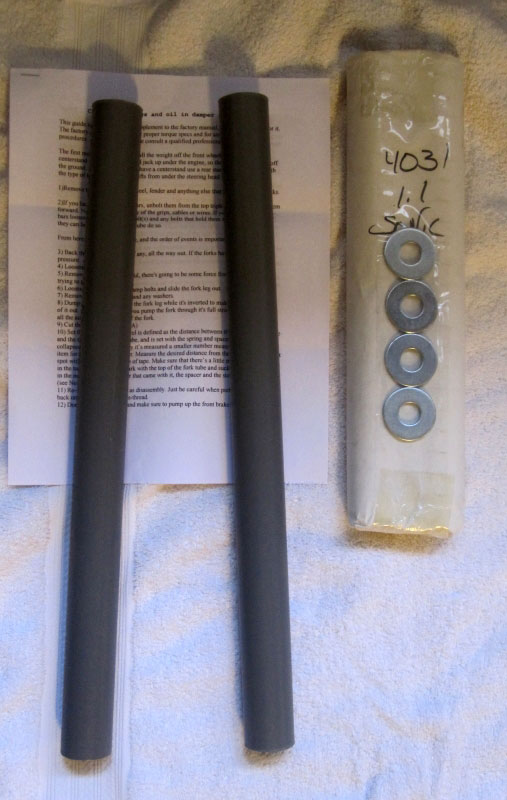
Rich mentioned by email that he threw in an extra section of spacer stock and it was a good thing, because the spacers needed to be a little longer than the stock spacers so the two long pieces of stock that were sent were both used. I also purchased a quart of PJ1 10W fork oil from Sonic, in case I needed to top up the oil; also a good thing because I ended up draining both fork tubes and replacing all the oil. One quart is just enough.
Having done this before, I had a pretty good idea of the tools needed. To remove and replace the fork caps, I've found nothing easier to use than a palm ratchet with a socket extension; this lets you turn with one hand [on the ratchet] and apply downward pressure with the other [on the extension] at the same time. Since this combination is easy to control, it helps prevent cross-threading the fork caps. I also made a simple oil level gauge; another easy time saver. Bend a straight piece of coat hanger (like in the photo) so that when hung into the fork tube, when the oil touches the bottom of the gauge, you're at the specified 106mm. I put a piece of heat shrink at the bottom to make it easier to see and another at the top to prevent scratches.
You'll also need some kind of syringe to add or remove small amounts of oil to get the level just right. You can use a kitchen turkey baster for this but be prepared to have medics on hand in case your significant other doesn't fully appreciate the elegance of that solution. I picked up a "MixMizer" (see the pic) at the local Walmart for less than $3.50. It comes with an extension tube and works perfectly for this.
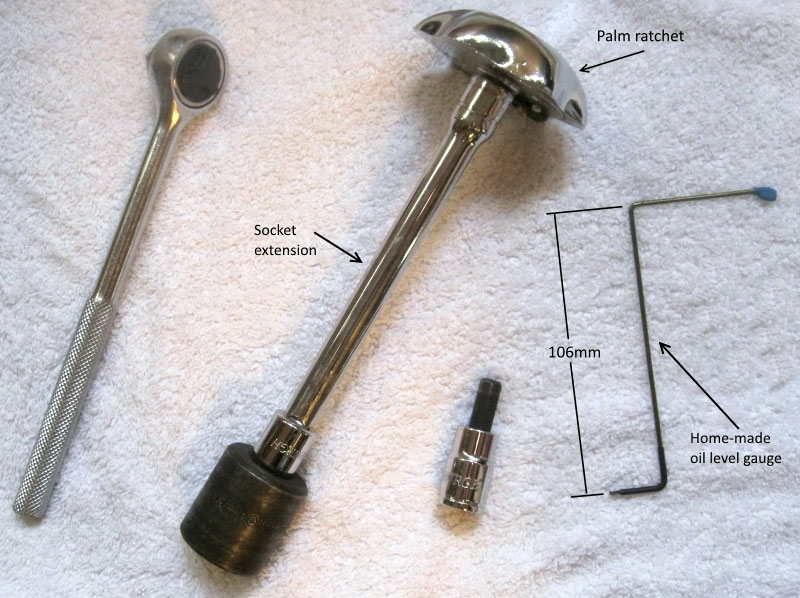

Another thing that'll save some time and hastle is an easy way to raise and lower the front wheel. You could just use the jack but I used one of my car ramps like a wedge; once the fork caps are removed, just lift the wheel and slide the ramp under the wheel to hold the tubes collapsed. To extend the tubes, again just lift the wheel, slide the ramp away and lower gently.
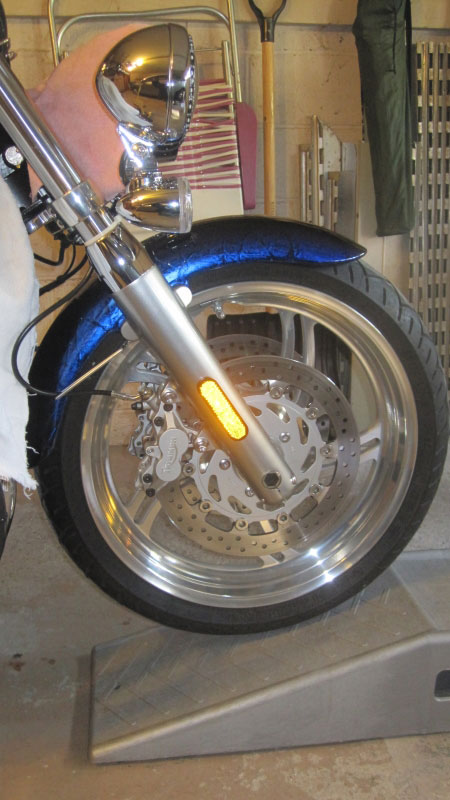
Before trying to remove the fork caps, loosen the upper yoke pinch bolts. With the fork caps off, extract the springs. To minimize the mess, I prop up the springs part way and let them drip back into the tubes for a few minutes.
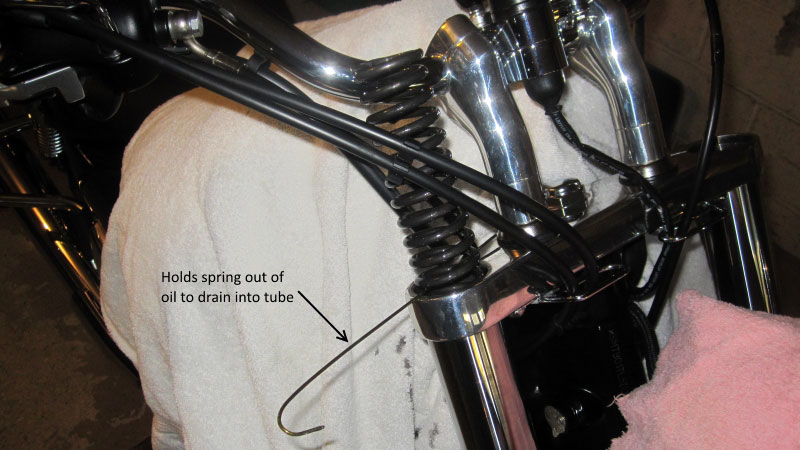
With the stock springs out, I was able to compare them with the Sonics. The Sonics are a bit shorter and a hair less diameter. I found the first set of washers supplied by Sonic to be just barely too small and with too small an opening. The opening size made a difference because with the forks extended, the washers would be submerged in the fork oil and the small washer hole could affect damping.
I notified Rich and sent photos and he promptly found perfect washers and shipped them to me.
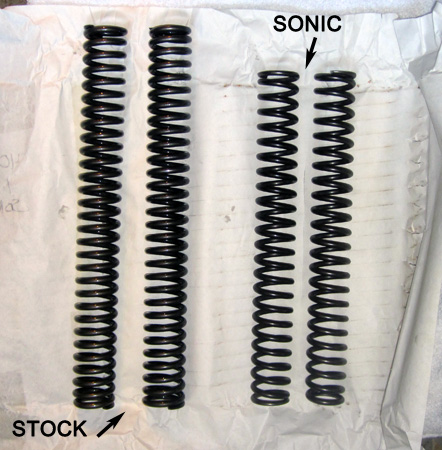
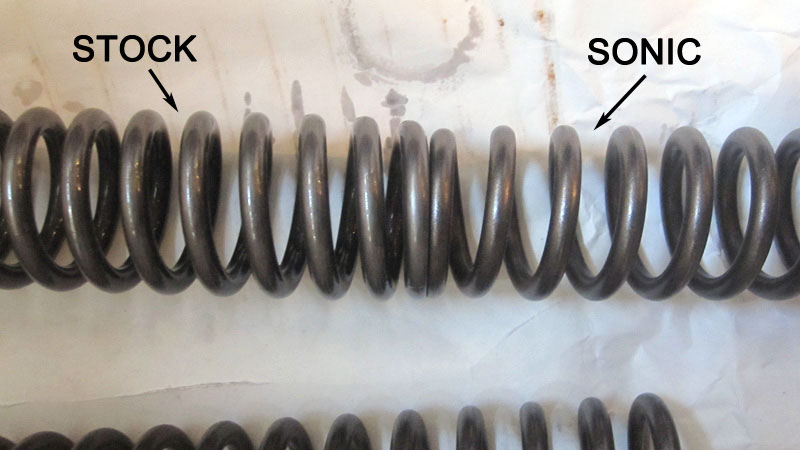
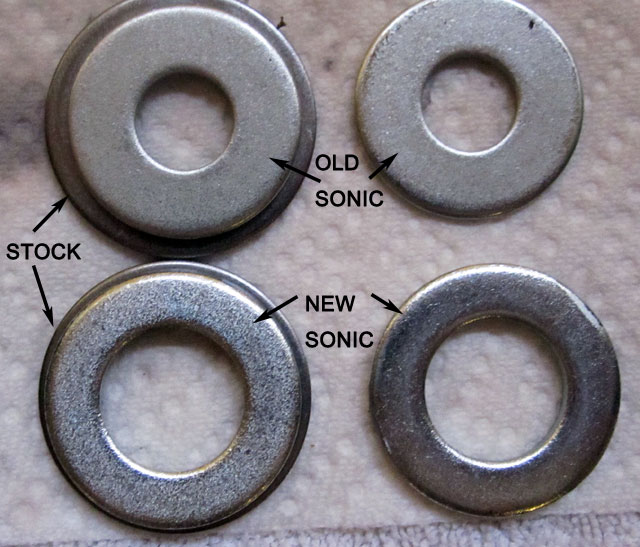
My bike being just over 1 year old, my intention was to not replace the fork oil, just to top it up if necessary. Wiping off the stock springs left a surprising amount of grunge behind so I sucked out some fork oil and couldn't believe how dirty it was. Where this crap came from is still a mystery; there was nothing to rust in the fork tubes and the seals were all good. Not even the hint of a leak anywhere and the levels were right in both tubes.
In the photo below, I've got a flashlight up against the wall of the jar and you can't see any light penetrating the old oil. Unbelievable.
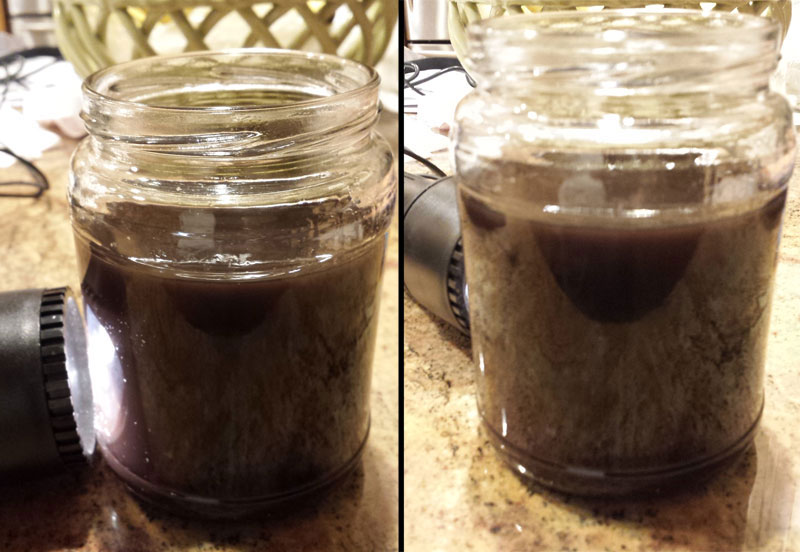
I pumped out both forks with a hand pump and was able to get all the way to the visible bottom of the tubes. The best way to drain the fork tubes is to remove the wheel (and all that entails), slide the tubes out and invert them. In this case, that was more than I was prepared to do so I'll run on the fresh oil for a year and then replace it again.
With the home-made fork oil gauge, setting the oil level is easy. Just pour in the oil (forks fully compressed) until it reaches the gauge; the forks are at an angle but with the oil line crossing the gauge at the center of the tube, it should be pretty much dead on. If you overfill, suck out a little at a time with a syringe/MixMizer/Turkey Baster.
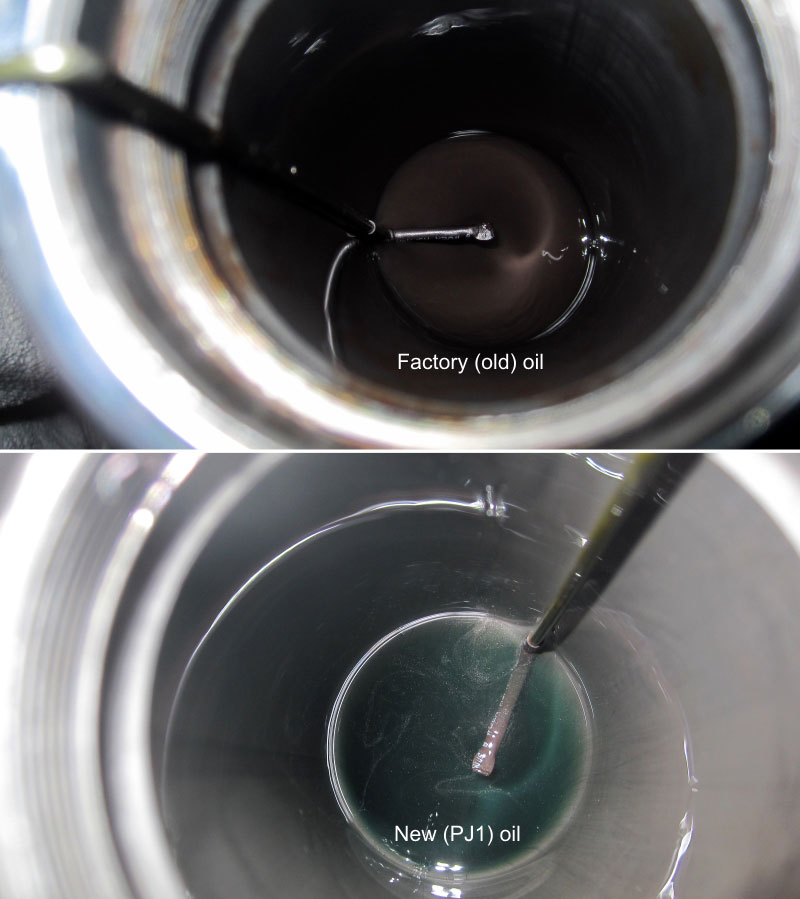
With the tubes filled with the correct amount of oil, drop the front wheel and pop in the new springs, the new spacers, then your best initial guess of spacer length. Always err on the long side; you can cut a spacer shorter but not longer. If you make the spacers a lot too long, you'll never get the caps back on; if you cut them too short, you won't have enough preload and your ride will suffer. Start with the new spacers an inch or so higher out of the tubes than the stock spacers were. If you can't get the caps back on, cut the spacers back 5mm at a time until you can.
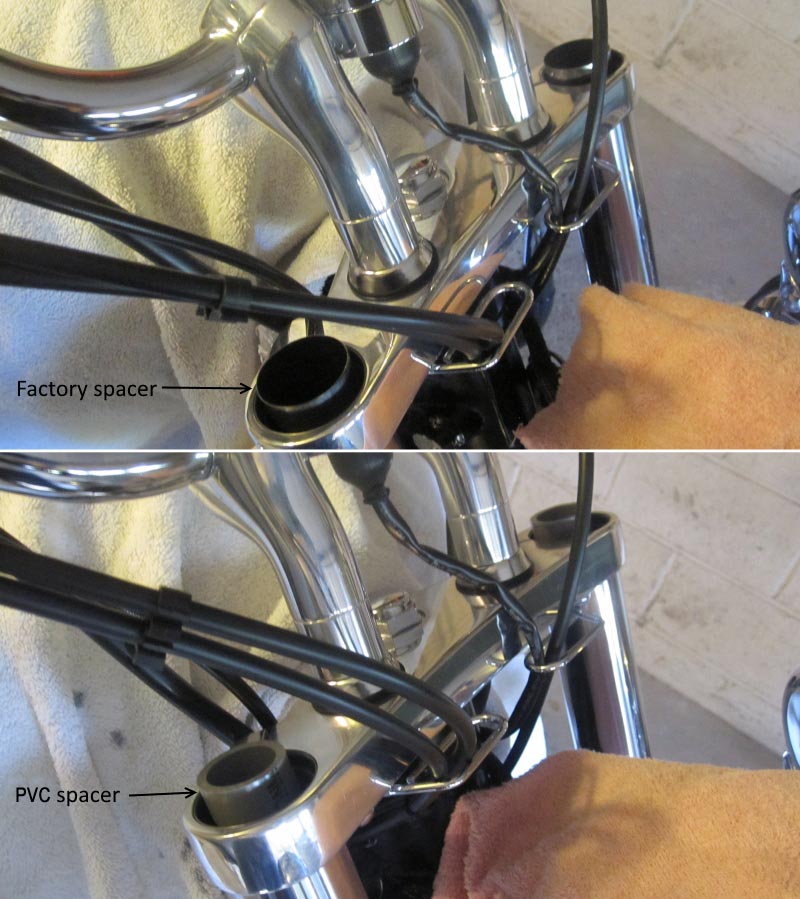
To set preload, gather up all the gear you typically ride with and hang it somewhere up front, like on the bars. Attach a nylon ziptie to one of the fork tubes, loose enough so it can slide up and down the fork tube but snug enough so it holds its place wherever it's put.
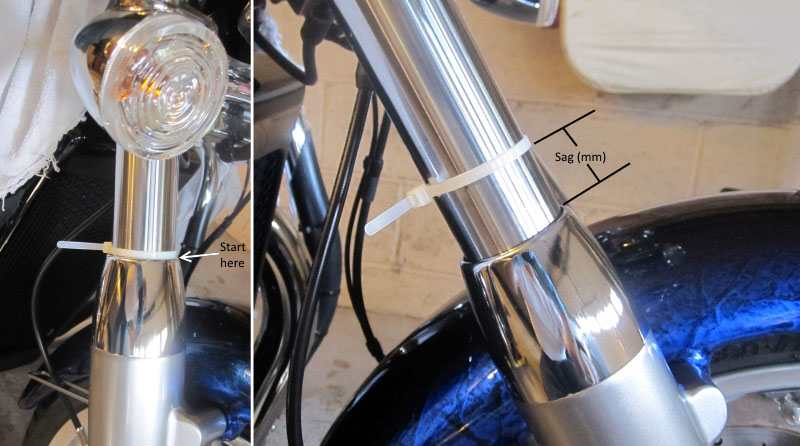
Lower the bike to the ground and slide the ziptie all the way down against the fork seal. The idea is that when you get on the bike and compress the forks with the new springs, the ziptie will be pushed up the tube and stop where the load is equalized, giving you a chance to take a measurement off the bike. You then jack the bike back up so the forks are fully extended and measure the distance from the fork seal to the bottom of the ziptie. That's your sag and you want it to be about 30% of fork travel. The Bird's specified fork travel is 120mm so 35mm, +/- a couple of mm, is your target. You may want to take this measurement a few times and average it.
I'm purposely avoiding references to "static" sag, "rider" sag, "laden" sag, "loaded" sag and on and on. Google all of these and you will find all sorts of contradicting definitions and everyone insists their definition is right. What we're talking about here is the front end sag with rider and gear in place while not moving. As long as we all understand the conditions, we shouldn't need to argue about it; if I was naming this, I'd call it "loaded static sag" since the bike is loaded and not moving but no one calls it that.
When you get on the bike to set the ziptie, you need to do it gently, without bouncing and you should get both feet off the ground (at least momentarily) so all your weight is in the seat.
Naturally, if your sag is greater than, say, 39mm, your spacers are too short and you need to cut new, longer ones. If your sag is less than, say, 31mm, cut down the spacers, a few mm at a time (or you'll be buying a lot of PVC conduit). Needless to say, every time you need to cut down the spacers, you'll need to jack up the bike, remove both fork caps, remove and clean off the spacers, cut them down, put em back in, lower the bike, etc. Yeah, it's a PITA but you only have to do this once (unless you gain/lose a lot of weight). It's worth it.
The first time I cut my spacers (long), I started pulling the material away from the saw before it completely stopped spinning and the blade ripped a small chunk out of the freshly cut lip of the spacer. I had no choice but to cut them down again, just past the jagged edge. I got the spacers in, lowered the bike, hung all my gear on the bars and lowered myself to the seat, jacked it back up and measured.....34mm! :-)
If you're new to this, please note that this preload setup only applies to fixed-rate springs. If you're putting in dual-rate or progressive springs, you'll probably just be reusing the stock spacers.
Don't forget to properly torque the upper yoke pinch bolts (20Nm) and the fork caps (22.5Nm).
I've already addressed the differences in ride and handling in other posts so I won't repeat it here but this is one of the best bangs for the buck around. It's really not that much work, not that much money, the risk is low and the payoff can be high.
Coming up next, rear shocks! :-)
Ride safe!
PapaSmurfMC
| 2013 Blue Marble Haze Thunderbird 1600 ABS
2009 Black Bonneville A1 ("Mag")
Buncha farkles
|
|
| | | AZCactus | | Taranis |  |  | | Reg. Date | : | 01/05/2013 | | Posts | : | 4,514 | | Location | : | AZ |
|
| | Posted : 16 Dec 2014 - 04:55 Post title : Re: Sonic Springs Linear Rate Fork Springs (Re: PapaSmurfMC) | | | Nice Work and documentation! I'll watch for the rear shock replacement too (mine in February).
| 2009 Thunderbird 1700 Big Bore
|
|
| | | drhach | | Set |  | | Reg. Date | : | 18/10/2011 | | Posts | : | 250 | | Location | : | Waukegan, Illinois, United States |
|
| | Posted : 16 Dec 2014 - 16:48 Post title : Re: Sonic Springs Linear Rate Fork Springs (Re: AZCactus) | | | Thanks so much for posting this. I have two questions if you don't mind. First, what did the springs run you pricewise? Second, what are your observations in terms of ride. Maybe a thrid question is how much do you weigh? I came in closer to 1.0 in my calculations and I wouldn't mind comapring your ride impressions and weight to my situation. I've been hoping you'd comment on this so that i cna place an order. THis is on my list of projects for the Winter.
Thanks,
Dan
|
|
| | | GerPa | | Jupiter |  |  | | Reg. Date | : | 10/12/2011 | | Posts | : | 1,919 | | Location | : | Mackay, Central Queensland, Australia |
|
| | Posted : 16 Dec 2014 - 20:15 Post title : Re: Sonic Springs Linear Rate Fork Springs (Re: PapaSmurfMC) | | | Nice write up. PaPa and Tremendous Photos.
One question.
When you pumped the oil out with the Forks institute, Did you record how much you put back in. ie.  Thus indicating whats left by not removing the forks. Thus indicating whats left by not removing the forks.
|  May-2011-1600, 20306 Tune, Mustang Vintage Solo Seat, Meerkat Cat Bypass, + Meerkat Modified Short TORS May-2011-1600, 20306 Tune, Mustang Vintage Solo Seat, Meerkat Cat Bypass, + Meerkat Modified Short TORS   ,K&N Air Cleaner,K&N Oil Filter, JBQ lifting system, Gold Plug Magnetic Sump Plug,Dart Fly screen, Rivco Risers, GiPro Gear Indicator, Breakaway Cruise Control, Avon ISO Grips, Scorpion Western Low Handlebars, Kury Switchblade Pegs, Garmin Zumo390LM,Michelin RC2 on Front RC 3 on ,Modified Rear Drive Pulley Hub Bearings (Mat1600/Alex4 Modification) Front Susp: Std & 7.5W Oil /126mm Air Gap & Rear:Hagon Nitro's with 26Kg/cm Springs + Lots of other "Bling" stuff. ,K&N Air Cleaner,K&N Oil Filter, JBQ lifting system, Gold Plug Magnetic Sump Plug,Dart Fly screen, Rivco Risers, GiPro Gear Indicator, Breakaway Cruise Control, Avon ISO Grips, Scorpion Western Low Handlebars, Kury Switchblade Pegs, Garmin Zumo390LM,Michelin RC2 on Front RC 3 on ,Modified Rear Drive Pulley Hub Bearings (Mat1600/Alex4 Modification) Front Susp: Std & 7.5W Oil /126mm Air Gap & Rear:Hagon Nitro's with 26Kg/cm Springs + Lots of other "Bling" stuff.
|
|
| | | Dags | | Set |  |  | | Reg. Date | : | 01/11/2013 | | Posts | : | 468 | | Location | : | N.S.W, Australia |
|
| | Posted : 16 Dec 2014 - 20:27 Post title : Re: Sonic Springs Linear Rate Fork Springs (Re: GerPa) | | | Just to echo GerPa, great write up.
Thanks for taking the time to compile and post the details.
|  Dags Dags
|
|
| | | PapaSmurfMC | | Chaac |  |  | | Reg. Date | : | 03/10/2013 | | Posts | : | 871 | | Location | : | Philadelphia, Pennsylvania, United States |
|
| | Posted : 17 Dec 2014 - 03:13 Post title : Re: Sonic Springs Linear Rate Fork Springs (Re: drhach) | | | Kudos appreciated, thanks all. 
drhach wrote:
... I have two questions if you don't mind. First, what did the springs run you pricewise? Second, what are your observations in terms of ride. Maybe a thrid question is how much do you weigh? I came in closer to 1.0 in my calculations and I wouldn't mind comapring your ride impressions and weight to my situation.
... |
|
Springs cost $85, washers and spacer stock included.
Front end tracks noticeably better, especially at low speeds, reduced brake dive, bumps handled better; forks travel only as much as they need to, no pogoing. Still not really sure but there might be a tiny increase in vibration at the grips. Big bumps seem to transfer more to the bars than to the frame now. I spent a day aiming for every road defect and railroad track in sight!
Typical gear (armored jacket, helmet, boots, gloves), front crash bars, windshield (Windvest), Triumph light bar and my fat carcass come to about 229 lbs.
GerPa wrote:
... When you pumped the oil out with the Forks institute, Did you record how much you put back in. ie. Thus indicating whats left by not removing the forks. ... |
|
I didn't (now I wish I had) measure the oil going in but I did use almost the full quart of oil. After the pump out, I was able to see metal at the bottom of the tubes, with almost no old oil pooled at the bottom. If I'd had 2 quarts of fresh oil, I probably would have flushed the tubes at least once before refilling.
| 2013 Blue Marble Haze Thunderbird 1600 ABS
2009 Black Bonneville A1 ("Mag")
Buncha farkles
| | Post edited by PapaSmurfMC on 17 Dec 2014 - 03:16 |
|
| | | drhach | | Set |  | | Reg. Date | : | 18/10/2011 | | Posts | : | 250 | | Location | : | Waukegan, Illinois, United States |
|
| | Posted : 17 Dec 2014 - 20:09 Post title : Re: Sonic Springs Linear Rate Fork Springs (Re: PapaSmurfMC) | | | Thanks, it sounds like we're similarly....dimensioned. 
Can you clarify what you mean by " Big bumps seem to transfer more to the bars than to the frame"? Is that a good thing?
|
|
| | | PapaSmurfMC | | Chaac |  |  | | Reg. Date | : | 03/10/2013 | | Posts | : | 871 | | Location | : | Philadelphia, Pennsylvania, United States |
|
| | Posted : 18 Dec 2014 - 03:30 Post title : Re: Sonic Springs Linear Rate Fork Springs (Re: drhach) | | | drhach wrote:
...Can you clarify what you mean by " Big bumps seem to transfer more to the bars than to the frame"? Is that a good thing? |
|
Less chassis upset is good. Talking about BIG bumps; the front end takes it without transferring much to the chassis. Don't lock your elbows. 
| 2013 Blue Marble Haze Thunderbird 1600 ABS
2009 Black Bonneville A1 ("Mag")
Buncha farkles
| | Post edited by PapaSmurfMC on 18 Dec 2014 - 03:32 |
|
| | | edbob | | Chaac |  |  | | Reg. Date | : | 04/04/2012 | | Posts | : | 931 | | Location | : | United States |
|
| | Posted : 18 Dec 2014 - 18:21 Post title : Re: Sonic Springs Linear Rate Fork Springs (Re: PapaSmurfMC) | | | My personal theory about the fork oil dirt is from the chrome fork shrouds that sit on top of the lower part of the fork. When I popped mine off, the insides were coated with rust, dirt, and corrosion. Only 2 years and 6500 miles...
| "You will ride eternal shiny and chrome"
|
|
| | | drhach | | Set |  | | Reg. Date | : | 18/10/2011 | | Posts | : | 250 | | Location | : | Waukegan, Illinois, United States |
|
| | Posted : 18 Dec 2014 - 22:57 Post title : Re: Sonic Springs Linear Rate Fork Springs (Re: edbob) | | | That dark oil is also likely oxidation from the aluminum sliders.
|
|
| | | drhach | | Set |  | | Reg. Date | : | 18/10/2011 | | Posts | : | 250 | | Location | : | Waukegan, Illinois, United States |
|
| | Posted : 13 Mar 2015 - 15:16 Post title : Re: Sonic Springs Linear Rate Fork Springs (Re: drhach) | | | I ordered mine earlier this week. They are supposed to arrive today. The next challenge will be finding the time to install them I can't wait. Lots of fiddlingin my furture. I took some oil out of the forks when I measured the springs. I'm trying to increase the air volume to soften the air spring a little. That gave me more fork travel, but more dive. So, heavier springs. Once I get the springs sorted (ais and mechanical) it will be time to play with damping via oil weights.
|
|
| | | PapaSmurfMC | | Chaac |  |  | | Reg. Date | : | 03/10/2013 | | Posts | : | 871 | | Location | : | Philadelphia, Pennsylvania, United States |
|
| | Posted : 14 Mar 2015 - 02:28 Post title : Re: Sonic Springs Linear Rate Fork Springs (Re: drhach) | | | | drhach wrote: .... Once I get the springs sorted (ais and mechanical) it will be time to play with damping via oil weights. |
|
Unless you enjoy that kind of thing, search around for posts from people who have changed fork oil weight. Pretty sure that everyone I saw who put in heavier weight oil switched back to the 10W. Setting sag properly is more important than almost anything else.
Once your new springs are in and you test them out, please post your impressions.
| 2013 Blue Marble Haze Thunderbird 1600 ABS
2009 Black Bonneville A1 ("Mag")
Buncha farkles
| | Post edited by PapaSmurfMC on 14 Mar 2015 - 02:28 |
|
| | | drhach | | Set |  | | Reg. Date | : | 18/10/2011 | | Posts | : | 250 | | Location | : | Waukegan, Illinois, United States |
|
| | Posted : 16 Mar 2015 - 13:46 Post title : Re: Sonic Springs Linear Rate Fork Springs (Re: PapaSmurfMC) | | | I do plan to stay with the 10w. I am going to put in new oil, but it will be the same weight (just a question of how much). I was initially thinking of changing the weights, but I think it's better to do one thing at a time and the more I research it, the more I'm led to sticking with the 10wt. I gues it will depend on how the sprtings work out. Definitley going to get the sag set properly. That's the next order of business after the springs are in. I'll make sure to post up here when I have some results; probably in a couple of weeks.
Dan
| | Post edited by drhach on 16 Mar 2015 - 13:48 |
|
| | | drhach | | Set |  | | Reg. Date | : | 18/10/2011 | | Posts | : | 250 | | Location | : | Waukegan, Illinois, United States |
|
| | Posted : 30 Mar 2015 - 13:46 Post title : Re: Sonic Springs Linear Rate Fork Springs (Re: drhach) | | |
Ok, so I did the big switch. I put in the 1.1kg spring from Sonic and also changed my oil. I wanted to keep this as an apple to apples comparison so I tried to stick with 10w oil (for now). I tried, but was not able to find the Showa 10w oil that the factory recommends. That led to an exhaustive search for oil. I turns out that oil weights for suspensions have no standard the way that they do for engines. So, 10w from one manufacturer can be vastly different form 10w from another in terms of viscosity. So, I found a table which relates oils in terms of true viscosites rather that weights. Form this, the closest match I could come up with was Silkolene 10W.
I got it all back together with little drama (other than jacking the damned thing up). One thing I was curious about, was fork travel. In other words, how much of my useable suspension am I really using. So I made a simple gauge to check it. I had previously tied zip ties to my forks. This was a good indicator for extreme movment, but I was really curious how often that extreme occurs and what else is going on. So I attached a coat hanger to the lower fork and ran the wire up by the handlebars. I marked rider sag position as well as the upper and lower limts of fork travel. After that, I attached anoterh wiore to the handlebars as a pointer.
Sorry for the blurry picture. But here it is:
[IMG]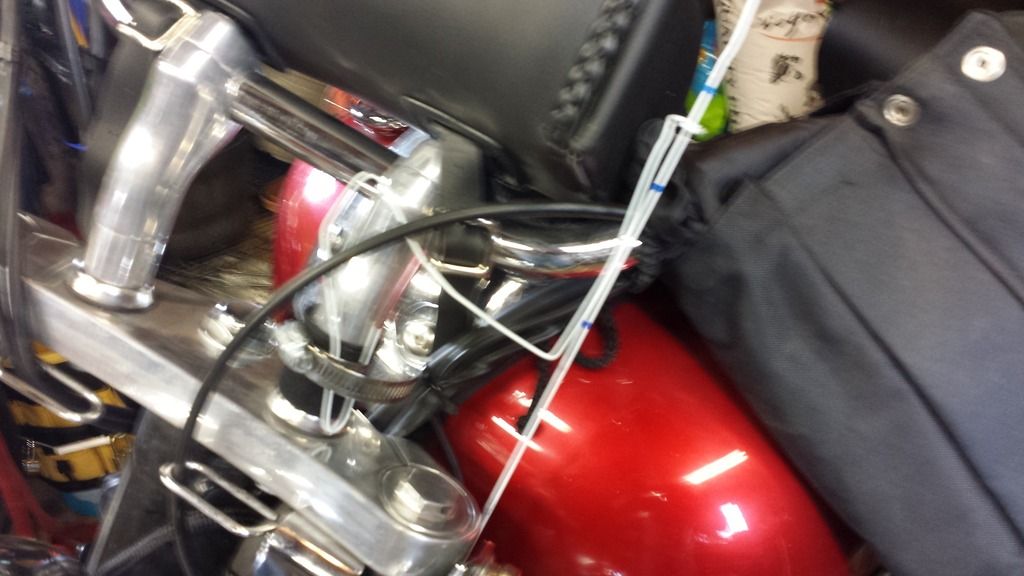
I really want to take perception out of this and just consider reality. So what am I finding? First of all, fork dive has sgnificantly reduced. I expected that given that I went to a heavier spring. Rebound is much better (but not great). There's a small, very bumpy sweeper on my commute. The front end definitely was gripping those bumps better and I felt more in control. Compression damping still sucks.
From the rider sag position, the forks are maybe moving 20mm. So, for a fork travel of 120mm, I'm not even touching 100mm of useable travel. What does that mean? Well, to me it means that I am soaking up the bumps instead of the forks. It tells me that I need to go to a lighter oil so that the forks can do what they are supposed to do. There is a lot more suspension available that I'm not using.
clearly there still is the issue of the rear shocks, but I think there is a lot more that can be done in terms of the front forks. I was really shocked (no pun intended) to see how little the front forks move, especially in compression.
I think, overall, I have the right spring. Diminished fork dive illustrates that. But there is definitely a lot more that can be done with compression damping.
To be continured.........
|
|
| | | PapaSmurfMC | | Chaac |  |  | | Reg. Date | : | 03/10/2013 | | Posts | : | 871 | | Location | : | Philadelphia, Pennsylvania, United States |
|
| | Posted : 30 Mar 2015 - 16:48 Post title : Re: Sonic Springs Linear Rate Fork Springs (Re: drhach) | | | Very scientific and clever inplementation  but I think you're expecting a lot from a spring. A while back, I saw you were considering retrofitting Gold Valve Emulators; anything ever come of that? but I think you're expecting a lot from a spring. A while back, I saw you were considering retrofitting Gold Valve Emulators; anything ever come of that?
As far as oil weights go, is this the table you're talking about?: https://transmoto.com.au/comparative-oil-weights-table/
Looking at just the 10W oils and throwing out the wacky, never-heard-of-it entries, the commonly found 10W viscosities don't seem to vary by more than about 6% and who knows what the batch-to-batch tolerances are within a brand. I used PJ1 10W. I've used it before (in different weights), has a decent rep, low foaming and got it directly from Sonic Springs with my order.
Maybe clarify one thing about fork travel. You saw 20mm of travel but you said that's from the rider sag position, which I'm assuming you set at close to 30mm? So, wouldn't that be 50mm out of the 120mm of fork travel, leaving 70mm of travel? And that's under normal or maybe mildly agressive riding so how much travel do you think you should keep in reserve for potholes, roadwork and kamikaze rodents? I'd think maybe 50mm would be reasonable and that would leave 20mm of headroom (for ramp jumps  ). ).
| 2013 Blue Marble Haze Thunderbird 1600 ABS
2009 Black Bonneville A1 ("Mag")
Buncha farkles
|
|
| | | drhach | | Set |  | | Reg. Date | : | 18/10/2011 | | Posts | : | 250 | | Location | : | Waukegan, Illinois, United States |
|
| | Posted : 30 Mar 2015 - 19:36 Post title : Re: Sonic Springs Linear Rate Fork Springs (Re: PapaSmurfMC) | | | Yes, "clever" is the latin word for "cheap"  I don't know. I think I'm pretty dialed in with the spring. I pored over Racetech's Suspension bible. Based on what I could come up with there, I'm good springwise. My take away from that is that spring rate primarily affects brake dive and oil affects damping. This is of course a huge over simplification. That being said, with the stock spring, I had huge brake dive and I've been able to minimize it pretty well with the new spring. I don't know. I think I'm pretty dialed in with the spring. I pored over Racetech's Suspension bible. Based on what I could come up with there, I'm good springwise. My take away from that is that spring rate primarily affects brake dive and oil affects damping. This is of course a huge over simplification. That being said, with the stock spring, I had huge brake dive and I've been able to minimize it pretty well with the new spring.
I used an oil table similar to that one. Here is a version of it.
Link
I took that chart and pasted it in to an excel file so that I could sort it by viscosity at 40 degrees C. You're right that batch to batch tolerances could change as well. There is clearly not as much oversite for this kind of thing. But you have to start somewhere. My preference would have been to get the Showa oil, but I couldn't find it easily.
Sag is set to 1/3 of fork travel. So, in my case 40mm from full extension. Actually it's a tad under that, maybe 36mm. That's with all of my gear and me on the bike.
Regarding fork travel, there still are 120mm available. If you set sag at 40mm, there's 80mm available for compression and 40mm available for rebound (extension). My comment of 20mm travel means that I'm deviating about 10mm on either side of the rider sag set point; compressing about 10mm above sag and rebounding about 10mm below. It may be more and not exactly the same amount on both sides. it's a little tough to stare at the gauge and watch the road. It's clear though that I'm nowhere near the outer limits of the fork's travel in compression or rebound and the two deviations are very similar.
One thing I can say is that we have some pretty crappy roads around here. So, if I'm hitting those at speed and still not even coming close to full travel, I can probably widen the operating window more. I also did a test to see where I'm at with the air spring component. I think I can take a bit more oil out of the forks to soften that up a little. I'll certainly get that dialed in before I buy more oil (removing oil is free).
There's a top out spring for full extension. So, I think my only real concern is bottoming the forks. I think at this point I would crash before that ever happened. I'll report back after I adjust the air spring.
Regarding emulators. I gues after much research, I'm not entirely sold on them. I called Race tech and the "Tech support" guy on the phone came off sounding like a complete moron and couldn't tell me anything other than what was printed on his cheat sheet. That was pretty disappointing given what is contained in their book. Also, emulators have been around for the older BMW's for some time. I've talked to many people who've used them and ultimately report that it's just not that much better. So given that it would be a custom application and less than glowing reviews, I'm holding off. Also, oil is cheap. So, I can play with that and try to get close.
|
|
| | | drhach | | Set |  | | Reg. Date | : | 18/10/2011 | | Posts | : | 250 | | Location | : | Waukegan, Illinois, United States |
|
| | Posted : 14 Apr 2015 - 13:28 Post title : Re: Sonic Springs Linear Rate Fork Springs (Re: drhach) | | | Ok, another update. I was going to go with straight 5w oil. I decided to mix the 10w and the 5w to get a little closer to maybe 7.5. I was concerned that 5W from 10W might be too much a of a viscosity jump. I got some Silkolene 5W yesterday. I took out 8 oz. of the 10W and put back 8 oz. of the 5W. There is improvement. Not a ton of improvement, but improvement. There is more suspension travel being used and the bike is more compliant. Actually there's a rebound test that I use. On one of our roads there is a series of ruts in a right handed sweeper. I can feel the front tire skip over these; indicating poor rebound damping. There was almost no skipping today. So, a definite improvement. It's also perceptibly more plush on bumps. I may add a little more 5W to the mix. But for now I'm holding off.
Now what I'm facing is that the back shocks are really getting the spotlight. I still get bucked out of my seat on bumps or the bike drops out from under me in dips. I don't doubt that it is also a contributing factor in my front suspentsion woes. So, for now, I am going to hold off on any more front suspension stuff until the back end is more sorted.
I have a plan for the rear shocks. If it works, it will be under $100. Top secret until I can test it. Stay tuned.
Dan
|
|
|
| |
| |
|